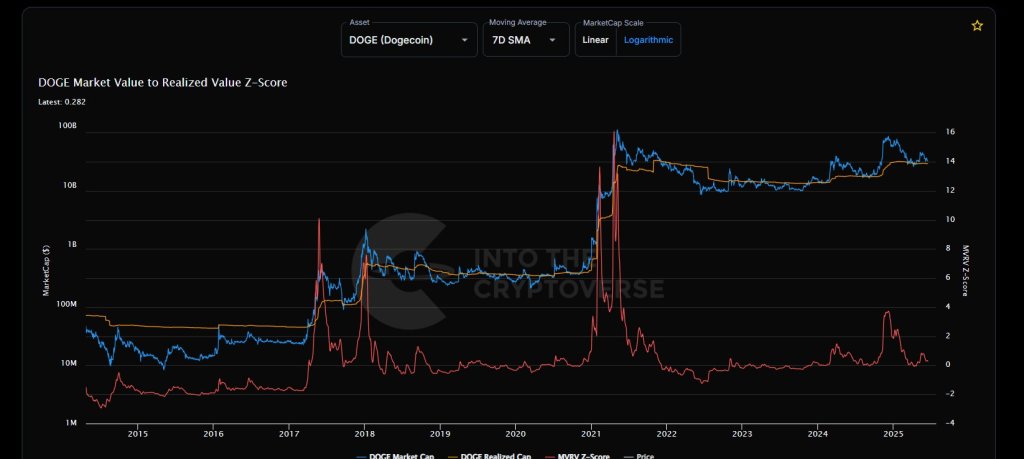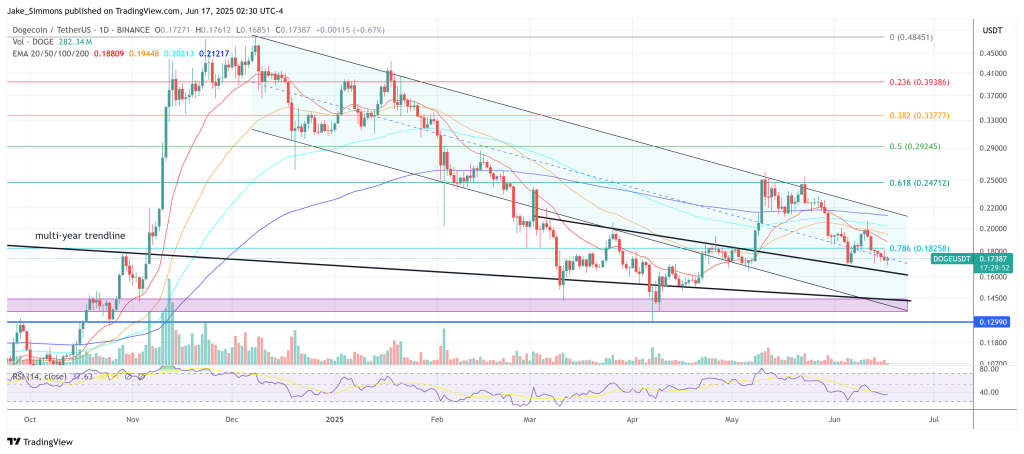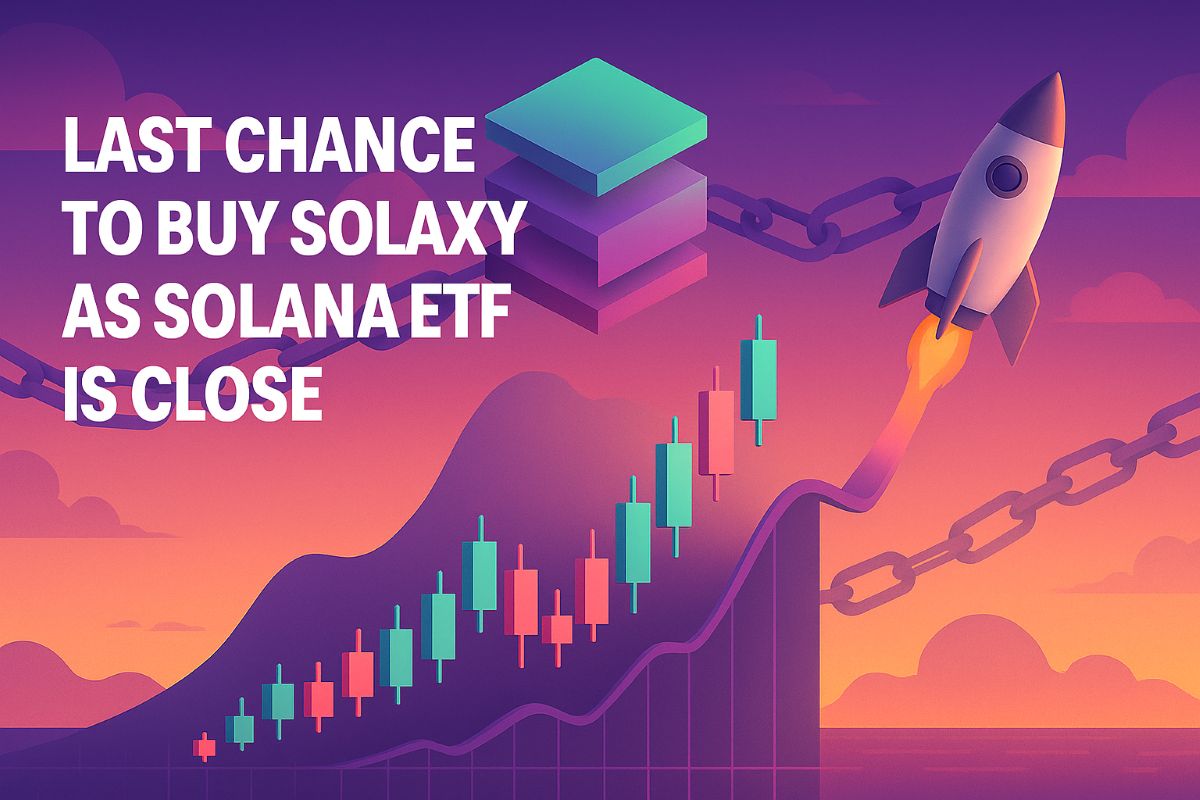Reason to trust
Strict editorial policy that focuses on accuracy, relevance, and impartiality
Created by industry experts and meticulously reviewed
The highest standards in reporting and publishing
Strict editorial policy that focuses on accuracy, relevance, and impartiality
Morbi pretium leo et nisl aliquam mollis. Quisque arcu lorem, ultricies quis pellentesque nec, ullamcorper eu odio.
Dogecoin’s Market-Value-to-Realised-Value (MVRV) Z-Score is printing just 0.28 – a level normally associated with capitulation, not euphoria. Yet the price of the ninth-largest cryptocurrency keeps carving a succession of higher highs and higher lows on the weekly chart, trading near $0.17 with a market capitalisation of roughly $26 billion in Monday’s late-New-York session.
The juxtaposition between lethargic on-chain sentiment and resilient spot bids was laid bare in a chart posted to X by Kevin, the pseudonymous analyst behind @Kev_Capital_TA. “Dogecoin MVRV Score is still at bear-market levels while price continues to make higher highs and higher lows on higher time frames,” he wrote.
Kevin also pointed out that previous cycle tops saw the Z-Score blow off at ≈11 in 2017 and ≈16 in 2021, whereas the current advance has so far peaked at 3.5. “#DOGE … has not seen a real bull run yet. This delay in durable Altcoins out-performance is very much due to restrictive monetary policy… It will change at some point and Alts will have their day in the sun.”

The Macro Backdrop For Dogecoin
The “restrictive monetary policy” Kevin cites remains the single most important head-wind for the entire alt-coin complex. In the US, the Federal Reserve has held the fed-funds target at 4.25 %–4.50% since January, having already delivered three cuts in 2024.
Related Reading
Futures markets this week imply the first additional reduction “around September or later,”after soft May inflation but a still-solid economy At the same time the Fed is only slowing — not stopping — quantitative tightening: beginning 1 April the monthly Treasury run-off cap fell to $5 billion from $25 billion, but Chair Jerome Powell made clear “there is no sign yet the Fed is ready to end QT.”
In Europe, the ECB has started to nudge borrowing costs lower, slicing the deposit rate to 2% on 5 June. President Christine Lagarde nevertheless insisted the Governing Council was “in a good position” to move gradually and would keep quantitative easing “in the toolbox,” rather than redeploying it. Vice-President Luis de Guindos was more explicit yesterday, telling Reuters that the ECB had “learned much more about side effects” of money printing and that the bar for new QE is now “higher.”
The net result is a world in which policy rates are still comfortably above neutral, liquidity is being drained by the Fed, and European officials are determined not to repeat the 2015-21 experiment of perpetual bond-buying. In Kevin’s words, this “delay” in easy money explains why alt-coins have under-performed Bitcoin so far in the 2024-25 cycle.
Reading The MVRV Tea Leaves
MVRV compares the aggregate market value of all coins with the value at which they last moved on-chain (their realised value). A Z-Score normalises that ratio against its own multi-year mean and standard deviation.
Historically for Dogecoin, values above +9 have coincided with secular tops (January 2018; May 2021), values between –1 and +1 have appeared during long lateral “crypto winters,” and values below –1 have signalled deep capitulation and, in hindsight, exceptional long-term entry points.
Related Reading
Today’s 0.28 sits squarely inside the winter band even though spot DOGE is up roughly 5x from its 2022 lows. The same disparity is visible within the chart: the blue line (market cap) has been rising since late 2023, while the red Z-Score remains pinned near zero because the orange line (realised cap) is climbing almost in lock-step as dormant supply changes hands at higher cost basis. In plain English, the average on-chain holder is not yet sitting on the kind of paper profits that breed euphoria.
When Could Policy Turn From Restrictive To Supportive?
Futures markets now look for two quarter-point Fed cuts by December, taking policy to roughly 3.75%. Market-implied odds of a September move fluctuate with each inflation print; should shelter and services dis-inflation stall, traders will push expectations into 2026.
However, neither the Fed nor the ECB is openly contemplating new asset purchases. Powell told reporters in March that the slower pace of QT is designed to “extend how far the central bank can run QT before needing to stop,” not to hint at a reversal. In Frankfurt, de Guindos stressed that “sometimes it’s much easier to start using [QE] than to withdraw it,” signalling that any relaunch would require either a financial-stability shock or a deep recession.
With QT still active and rate-cut trajectories shallow, a powerful systemic tail-wind for DOGE may not materialise until after the first Fed or ECB pause in balance-sheet contraction. If consensus is correct that QT ends late-2025 or early-2026, any prospective QE would be a story for the next downturn, not this upswing.
Kevin’s interpretation hinges on potential energy. Because the Z-Score has not yet detached from its mean, Dogecoin can, in theory, absorb a fresh wave of retail and leverage-driven inflows without immediately flashing the kind of overheated signal that coaxed sellers in 2017 and 2021. Put differently, DOGE’s spring has not been compressed.
Macro, however, remains the gating factor. “Buy them low and sell them high. Never get attached to your Alts,” the analyst reminds followers. For now, low MVRV suggests structural downside is limited, but cyclicality implies explosive upside will likely coincide with a convincing turn in global liquidity – a turn that the Fed and the ECB, by their own admission, are not yet ready to deliver.
At press time, DOGE traded at $0.17387.

Featured image created with DALL.E, chart from TradingView.com






